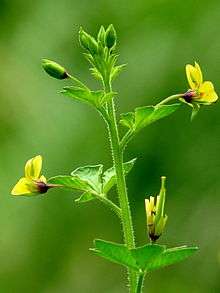Cleome viscosa
Cleome viscosa, the Asian spiderflower[2] or tick weed[3] is an annual herb that grows up to a meter high. It belongs to the family Cleomaceae. It's considered an invasive species and it is widely distributed in warm and humid habitats across the Americas, Africa and Asia.[4] It is commonly found during the rainy season.
| Cleome viscosa | |
|---|---|
 | |
| Scientific classification | |
| Kingdom: | Plantae |
| Clade: | Tracheophytes |
| Clade: | Angiosperms |
| Clade: | Eudicots |
| Clade: | Rosids |
| Order: | Brassicales |
| Family: | Cleomaceae |
| Genus: | Cleome |
| Species: | C. viscosa |
| Binomial name | |
| Cleome viscosa | |
| Synonyms[1] | |
| |
The crushed leaves have been investigated as a treatment for stored seeds of cowpea, to prevent weevil infestation.[5]
The leaves are used as external application to wounds and ulcers. The seeds are anthelmintic and carminative. The juice of the leaves is used as a remedy against discharge of pus from the ear. In a study comparing C. viscosa to standard antibiotics, it was proven to be effective at inhibiting microbial growth. This demonstrates its effectiveness as an antimicrobial agent in comparison to the antibiotic tetracycline.[6]
In northern India, the seeds (called Jakhya) are used as a culinary herb, mainly for tempering.
Description
Plants (10–)30–100(–160) cm. Stems viscid. Leaves: petiole 1.5–4.5(–8) cm, glandular-hirsute; leaflet blade ovate to oblanceolate-elliptic, (0.6–)2–6 × 0.5–3.5 cm, margins entire and glandular-ciliate, apex acute to obtuse, surfaces glandular-hirsute. Racemes 5–10 cm (10–15 cm in fruit); bracts (often deciduous), trifoliate, 10–25 mm, glandular-hirsute. Pedicels 6–30 mm, glandular-hirsute. Flowers: sepals green, lanceolate, 5–10 × 0.8–1.2 mm, glandular-hirsute; petals arranged in adaxial semicircle before anthesis, radially arranged at anthesis, bright yellow, sometimes purple basally, oblong to ovate, 7–14 × 3–4 mm; stamens dimorphic, 4–10 adaxial ones much shorter with swelling proximal to anthers, green, 5–9 mm; anthers 1.4–3 mm; ovary 6–10 mm, densely glandular; style 1–1.2 mm. Capsules dehiscing only partway from apex to base, 30–100 × 2–4 mm, glandular-hirsute. Seeds light brown, 1.2–1.8 × 1–1.2 mm, finely ridged transversely. 2n = 20.
Phenology
June–August (summer)
References
| Wikimedia Commons has media related to Arivela viscosa. |
- The Plant List: A Working List of All Plant Species, retrieved 17 May 2016
- "Cleome viscosa". Natural Resources Conservation Service PLANTS Database. USDA. Retrieved 21 October 2015.
- "Cleome viscosa". FloraBase. Western Australian Government Department of Parks and Wildlife.
- "Cleome viscosa (Asian spiderflower)". www.cabi.org. Retrieved 2020-03-05.
- Dabire, C.L.B.; Niango Ba, M.; Sanon, A. (2008), "Effects of crushed fresh Cleome viscosa L. (Capparaceae) plants on the cowpea storage pest, Callosobruchus maculatus Fab. (Coleoptera: Bruchidae)", International Journal of Pest Management, 54 (4): 319–326, doi:10.1080/09670870802266953
- "Antimicrobial Effects of Cleome Viscosa and Trigonella Foenum Graecum Seed Extracts" (PDF). Journal of Cell and Tissue Research. Vol. 8(2). 3 February 2008.